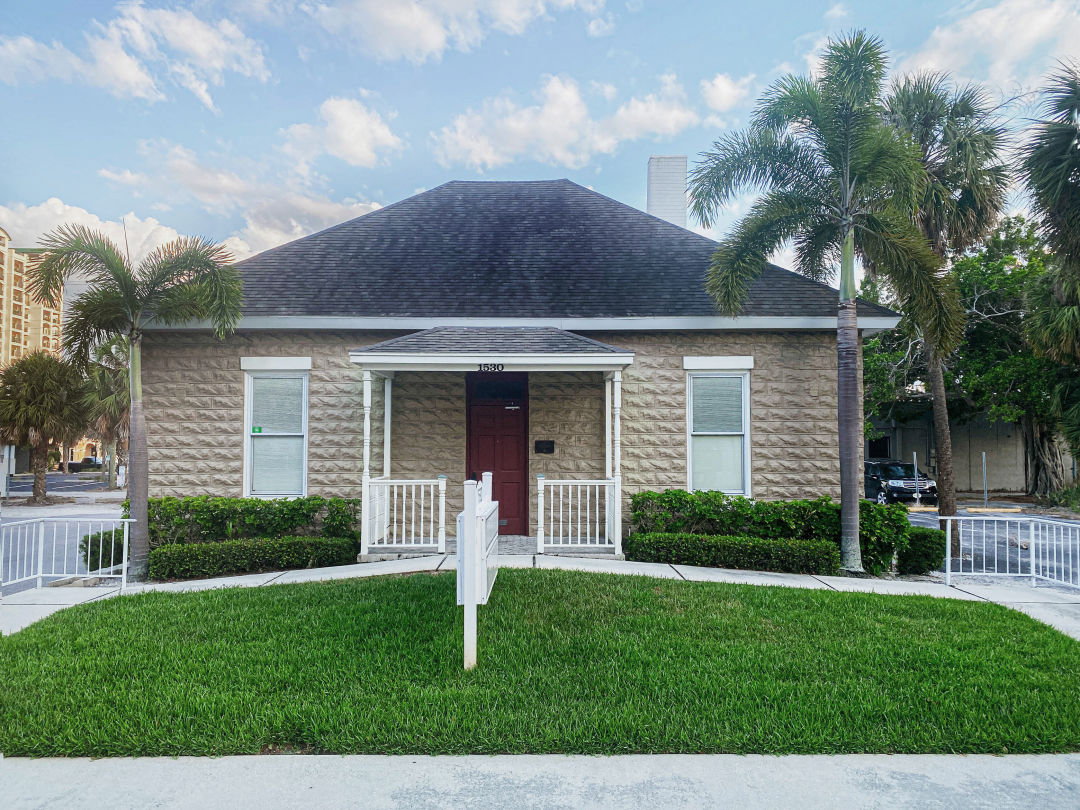This Historic Home Needs a New Home

The McAlpin Home is located at 1530 Cross St. in downtown Sarasota.
Image: Kim Doleatto
The future of a slice of Sarasota's history is uncertain for now. The historic McAlpin Home, located at 1530 Cross St.—near Burns Court in downtown Sarasota—is part of the roughly 3-acre, $32 million parcel that was recently purchased by developer Orange Pineapple LLC., which has plans to redevelop the property. Built in 1912, the McAlpin Home was once the residence of George McAlpin, known for his concrete work throughout Laurel Park and the bayfront before the City of Sarasota was incorporated.
McAlpin was "a real mover and shaker, and a partner with Owen Burns,” noted City of Sarasota senior planner Clifford Smith at yesterday’s Historic Preservation Board meeting. Smith is also the secretary of the Historic Preservation Board. “He invented the rusticated block. The blocks [that were made to build the McAlpin Home] are not all identical, so when you look [at the house], it's not one size fits all. It’s very unique."
The single-story home was locally designated a historic structure in 1984, granting it certain protections.
The meeting weighed the developer’s wish to demolish the McAlpin Home and make way for what we can assume will eventually be a mixed-use project in line with its zoning and prime central location. The parcel is zoned “downtown core,” which means up to 10 stories are allowed, with a density of 50 units per acre—the highest allowed in the city.
The Historic Preservation Board instead voted to recommend denial of the demolition and suggested the developer investigate moving the 1,792-square-foot home in order to preserve it.
The managing member of Orange Pineapple LLC is Christopher McGrew, the founding partner and chief executive of Steele Harbour, based in Tysons, Virginia. McGrew declined to comment for this story. At the meeting, representative Makaire King, of the local law firm Icard Merrill, presented his case, arguing that demolition was the best option and that the home was too high to move. However, reports produced by the former owner indicated otherwise.
Last year, the former owner of the parcel, Capstone Group Holdings, received the OK to move the home roughly 100 feet west, to the former site of Nancy's Bar-B-Q at 301 S. Pineapple Ave., on the corner of South Pineapple Avenue and Cross Street. It was found to be feasible by R.E. Johnson & Son house movers and cost the applicant just under $125,000. At the time, Snell Engineering Consultants had also provided a letter indicating it could be moved. One board member suggested picking up on those plans.
The current owner of the parcel would need to reapply, but the board said since it had granted permission in the past, that it would likely do so again.
But the applicant claimed moving the home would not “allow for reasonable economic return” and after moving would require costly updates like new plumbing and interior renovation.
Application materials indicated the home's new owner had already spent significant time seeking out someone to receive it, including the city and county, but had no success. The materials also included a report by Sarasota Architectural Salvage indicating that due to some minor renovations over the years, the home no longer carried any “significant quantities of economically salvageable historical features.”
But the Historic Preservation Board disagreed, saying that the rusticated, pre-cast concrete hollow block structure “reflects the broad cultural, political, social or economic history of the City of Sarasota,” is “associated with the life of a person who has played a significant role in our history” and “embodies the distinctive characteristics of an architectural style.” The rusticated blocks, which were poured into a mold now no longer in existence, were deemed by board members "difficult to impossible" to reproduce. The board also highlighted that few homes built of the specific block during the early 1900s remain. At the time, they were valued for their fire resistance—especially when most homes were made of wood.
In 1904, George and Margaret McAlpin arrived in the area from Atlanta. In 1911, McAlpin and Owen Burns formed the Burns & McAlpin construction company. For the next 10 years, they laid more than 10 miles of sidewalk, as well as curbs and gutters. They also laid the foundation of Hotel Higelhurst (then known as the Siesta Hotel). In 1915 they dissolved their company, but McAlpin kept working. He died in 1922 and left the house to his wife and son William; however, after he died, records on the family became sparse. The home has changed hands eight times since McAlpin's death and has been used both residentially and commercially.
"It's not grand, but it speaks more to our shared heritage when it’s that way," says Lorrie Muldowney, president of the Sarasota Alliance for Historic Preservation. “None of us grew up in a Ca' d' Zan. Our heritage is homes that are vernacular and modest. Those are the homes most of us live in."
In support of moving the McAlpin Home, the Historic Preservation Board also pointed to the historic Wilson Home, which was successfully moved in different pieces and is now preserved at its new address at Urfer Family Park.
In response to questions about economic return, one board member replied, "There's no comparing economic return on a house like this with a 10-story, 50-unit density building." A public speaker at the meeting, Janice Cohen, added that she worried that many historic structures would be sacrificed for development. "It's an emotional thing,” Cohen said.
The developer claimed that more recent additions to the home affected its historic value. But “the additions are immaterial," Smith said. “The rusticated block is really what we’re talking about." The applicant can choose to appeal the decision in ten business days and bring the question to the City of Sarasota Commissioners.
Potential plans to vacate Cross Street are also in the works, with an upcoming community workshop scheduled for July 18. The workshop is among the steps necessary for the developer to submit future plans for the site, and public comments will be recorded and considered at future meetings.

Cross Street is highlighted in yellow.
Image: Google Maps
Cross Street is currently used as a one-way access drive traveling west to east. Its width is 28 feet, with striping for parallel parking. Detailed development plans have not been provided, as the design of any potential site plan depends on the ability to vacate the street.
“In this town, you have grand ideas, but real estate changes daily, so the last thing we'd want is to have [the McAlpin Home] demoed, only to find the project didn't move forward as planned," Muldowney says. "We lost the train depot [which was demolished in 1986 after being listed on the National Register of Historic Places] that way, and the site sat vacant for many years. As preservationists, we like to keep our options open. Once a building is gone, we no longer have any options."



